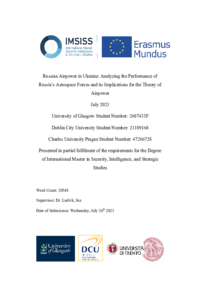Russian Airpower in Ukraine: Analyzing the Performance of Russia's Aerospace Forces and its Implications for the Theory of Airpower
Ruská letecká síla na Ukrajině: Analýza výkonu ruských leteckých sil a jejích důsledků pro teorii letecké síly
diplomová práce (OBHÁJENO)

Zobrazit/
Trvalý odkaz
http://hdl.handle.net/20.500.11956/187376Identifikátory
SIS: 259488
Kolekce
- Kvalifikační práce [19618]
Autor
Vedoucí práce
Oponent práce
Ó Beacháin, Donnacha
Fakulta / součást
Fakulta sociálních věd
Obor
International Master in Security, Intelligence and Strategic Studies (IMSISS)
Katedra / ústav / klinika
Katedra bezpečnostních studií
Datum obhajoby
21. 9. 2023
Nakladatel
Univerzita Karlova, Fakulta sociálních vědJazyk
Angličtina
Známka
Výborně
2687344F - 47266728 Russian Airpower in Ukraine: Analyzing the Performance of Russia's Aerospace Forces and its Implications for the Theory of Airpower Abstract A heated debate emerged in the West regarding the reasons behind the seemingly underwhelming performance of Russian airpower in Ukraine. Yet although many experts in the field have advanced their own hypotheses, few have put their ideas to the test through empirical analysis and the scientific method. This essay aims to address this gap in the literature by using explaining- outcome process tracing to comprehensively reconstruct Russia's blitzkrieg strategy to conquer Ukraine and examine the performance of the VKS in the skies over Ukraine. The timeframe for the reconstruction of events spans from February 24th , 2022, the day Russia launched the invasion, to the end of March and early days of April 2022, when the so-called first phase of the war ended following Russia's retreat from the northern axis. By analyzing the evidence thus gathered, this essay then seeks to provide an explanation for why the VKS did not achieve air supremacy. More precisely, this essay concludes that the inability of the VKS to assert uncontestable control over Ukrainian airspace was the result of a nonlinear synergistic interaction of multiple factors: (1) the lack of...
